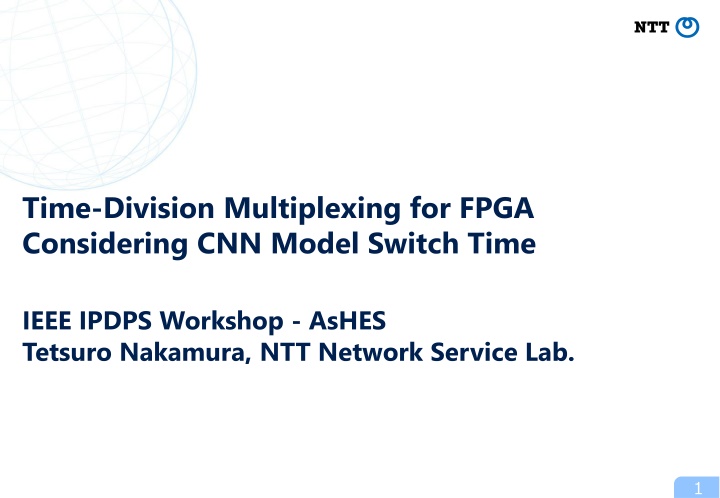
Optimizing FPGA Sharing for CNN Acceleration in Edge Computing Environment
Explore the implementation of Time-Division Multiplexing for FPGA in the context of CNN model switch time at the IEEE IPDPS Workshop. The agenda covers edge computing, system requirements, accelerator sharing analysis, feasibility evaluation, proposed methods, user performance evaluation, and future work. Learn about the potential of sharing FPGAs among users in edge computing for improved resource efficiency, fairness, and real-time performance.
Uploaded on | 2 Views
Download Presentation

Please find below an Image/Link to download the presentation.
The content on the website is provided AS IS for your information and personal use only. It may not be sold, licensed, or shared on other websites without obtaining consent from the author. If you encounter any issues during the download, it is possible that the publisher has removed the file from their server.
You are allowed to download the files provided on this website for personal or commercial use, subject to the condition that they are used lawfully. All files are the property of their respective owners.
The content on the website is provided AS IS for your information and personal use only. It may not be sold, licensed, or shared on other websites without obtaining consent from the author.
E N D
Presentation Transcript
Time-Division Multiplexing for FPGA Considering CNN Model Switch Time IEEE IPDPS Workshop - AsHES Tetsuro Nakamura, NTT Network Service Lab. 1
Agenda . INTRODUCTION Edge computing / System requirements . ANALYSIS FOR ACCELERATOR SHARING Target usecase / CNN acceleration on FPGA / Time-division multiplex FPGA . MACHINE PRE-EVLUATION FOR FEASIBILITY CNN model switch cost on FPGA / Optimization difficulties per CNN models . PROPOSED METHOD System architecture / Scheduling algorithm . EVALUATION User Performance / Fairness among users / Resource efficiency . CONCLUSIONS and FUTURE WORK 2
. INTRODUCTION Edge Computing Cloud to Edge Computing Improvement on Latency, Saving Network Traffic Any Improvement on Resource Efficiency ? CPU to Heterogeneous Resources GPU High throughput / High Performance on Deep Neural Network FPGA Low Latency / Low Power Consumption Monolithic Design / Fixed Resource in Edge+Cloud Potential Low Utilization / Over-Provisioning Can t we share FPGAs among users in Edge Computing? 3
. INTRODUCTION System Requirements System requirements to share FPGA among multiple users 1. Resource Efficiency Maximized Device Utilization Minimum Cost to Switch Device Users 2. Fairness between Users No monopolization of the shared device / No Resource Starvation Max-min Fairness 3. Real Time Performance Minimum Turn Around Time / Minimum Response Time 4. Hardware Abstraction Dynamic Resource Scale Brings Agility to Service 4
. ANALYSIS FOR ACCELERATOR SHARING Target Application / Use Case: Inference for Images / Video Streaming on Edge Server Convolutional Neural Network (CNN) Algorithm on FPGA Concurrent Requests from Multiple Users What is CNN ? Deep Neural Network for Recognizing / Classifying Images Various CNN algorithm models with Different Layer Depths and Sizes Single Shot Detector (SSD): Object Detection Residual Network (ResNet): Image Classification 5
. ANALYSIS FOR ACCELERATOR SHARING Acceleration models of CNN algorithms on FPGA Fixed-Model Acceleration Static lay out of a CNN model on internal FPGA chip Effective Performance Less Flexibility Hardware reconfiguration necessary to switch CNN model Programmable-Model Acceleration Load CNN model on FPGA off-chip device memory More Flexibility Support concurrent requests of various kinds of CNN models We focus on Programmable-Model Acceleration to build Time-multiplexed FPGA sharing system 6
. ANALYSIS FOR ACCELERATOR SHARING How Programmable-Model CNN Accelerators work Host Memory Common processing part by hardware chip that can support various CNN models PCIe Bus FPGA Chip FPGA Device memory Output Matrix Load Input Input Matrix 32x32x1 32x32x1 1x1x6 1x1x6 Parallel Processing Hierarchical Loop Supported calculation instructions CNN Algorithm Model Biases Input Matrix Input:32x32x1 Conv1 Model Information Conv1:28x28x20 Conv Pooling1 Weights, Biases Pooling1:14x14x20 Conv2 Conv2:10x10x20 Pooling Pooling2 Results Pooling2:5x5x20 Conv3 Fully Conv3:3x3x20 Fully Store Output Fully:1x1x6 Different between CNN algorithms and models 7
. ANALYSIS FOR ACCELERATOR SHARING Time-division sharing of FPGA device Support Context Save in FPGA Enables to preempt jobs at any time, as well as CPU Two ways to save FPGA context / state Inside FPGA : High *spatial* cost In host memory : High *time* cost No Context Save in FPGA Each Job assumed as non-preemptive Switch users at reasonable job granularity Switch users only when no state to save is retained internally in FPGA i.e. per inference execution for an image frame ( milliseconds) We focus on no context save switch (because actual inference time is short enough) 8
. MACHINE PRE-EVLUATION FOR FEASIBILITY Evaluated programmable-model accelerator with two CNN models Single Shot Detection (SSD) model size: 4.5 MB model switch time: 3.9 ms inference execution time: 20.62 ms Table I. Evaluation Environment Server CPU Host Memory FPGA OS Driver Dell R740 PowerEdge Intel Xeon Gold 5118 96 GB Xilinx Alveo U50LV Ubuntu 18.04.4 XRT 2019.2 Hardware Residual Network 50 (ResNet50) model size: 54 MB model switch time: 48.9 ms inference execution time: 11.58 ms Software (Note: model switch time is the time to transfer the model parameter from host memory to device memory) The first problem: Model/User switch cost is not negligible compared to execution time 9
. MACHINE PRE-EVLUATION FOR FEASIBILITY Throughput Analysis on Different CNN models SSD needs three threads to maximize the throughput while ResNet50 doesn t Each model require detailed hardware tuning while the requirement of resource hardware abstraction prevents it. The second problem: Model difference in the optimal number of FPGA execution threads 10
. PROPOSED METHOD System Architecture 1. Switch cost is not negligible New Algorithm Proposed: [Switch Aware WFQ] Minimizes Switch cost Ageing Technique with Weighted Fair Queuing 2. Difference among models Thread Manager Integrated: Prepares thread groups for each model Pays out threads on demand to optimal numbers automatically 11
. PROPOSED METHOD Scheduling Algorithm Existing Fair Scheduling Algorithms for CPU Complete Fair Scheduler, Multi-level Feed Back Queue Not suitable since they depend on CPU context switch Weighted Fair Queueing (WFQ) Algorithm Used in area of network bandwidth control Select job with earliest virtual finish time Implicitly use ageing technique Prevent resource starvation SAWFQ: switch-aware WFQ proposed Extension of WFQ to take switch cost into account Introduces virtual jobs for model switches switch penalty : the burst time of the virtual model switch jobs 12
. PROPOSED METHOD Scheduling Algorithm How to Optimize the scheduler parameter Switch Penalty ? We created SAWFQ simulator, simulated many times Finally found there is an optimal value for switch penalty Simulated Two Cases: Periodic Arrival: Streaming Request Random Arrival: On Demand Request Smaller switch penalty is faster, but it bursts at an optimal point 13
. PROPOSED METHOD Scheduling Algorithm Formulation of optimal Switch Penalty for CNN models Job Request Interval: ?? Job Request Rate: 1/?? Cycle period of all the model executions: ?????? Amounts of executed jobs for a model in a cycle: ?? Job Execution Rate: ??/?????? Burst Condition: execution rate larger than request rate 1/?? ???????? ???????? ????????< ??/?????? ( ) E.g. Switch between Two models: ?????? time Switch Time ??jobs Switch Time Switch Time 14
. PROPOSED METHOD Scheduling Algorithm Note WFQ calculates virtual time dividing actual time by weight (??), so switch penalty (?? ???????) and switch time (?? ????? ) are weighted in actual time ??????? ?? ??????? ????? ?????????, ?????? ??= ???? ?? = ????? Then, the burst condition ( ) becomes 1 ????????? 1 1 ?? ( ??= ????? ????????> ?? ?? ???) ???????? ?? ?? ?????? time ??????? ???? ????? ???? ??jobs 15
. PEFORMANCE EVALUATION Implemented the System of SAWFQ on FPGA The System Evaluated with Traditional Algorithms FCFS (First Come First Served), RR (Round Robin) Three Evaluation Points: 1. User Performance 2. Fairness Among Users 3. Resource Efficiency Table I. Evaluation Environment Server CPU Host Memory FPGA OS Driver Dell R740 PowerEdge Intel Xeon Gold 5118 96 GB Xilinx Alveo U50LV Ubuntu 18.04.4 XRT 2019.2 Hardware Software Two CNN Models on Programmable-Model Accelerator: SSD, ResNet50 Each CNN user issues inference requests periodically 16
. EVALUATION User Performance Requirement (3) Real-Time Request Interval Time: SSD: 30ms , ResNet50: 55ms Load where Jobs have a little waiting time in queues Metrics1: Scheduling Overhead 130-170 us Metrics2: Turn Around Time Turnaround Time (ms) Round Robin Worst Mean 478 16,781 508 29,434 Model SAWFQ Mean 278 196 FCFS Worst 33,154 42,111 Mean 19,552 19,591 Worst 38,911 38,996 SSD Resnet Better performance - SAWFQ can minimize the switch costs since it is aware of switch time thanks to the concept of switch penalty 17
. EVALUATION Fairness Among Users Requirement (2) Fairness Among Users Request Interval Time: 1. SSD Low Load - SSD: 30ms , ResNet50: 55ms 2. SSD High Load - SSD: 5ms , ResNet50: 55ms Metrics3: FPGA Total Utilization Time Ratio Between Users (Models) Why Not Total Utilization Time? - Waiting Time / Slowdown not suitable Waiting time orders differs too much between algorithms Note 100 % is completely fair FCFS: Vulnerable to request load Round Robin: Robust to request load, but not good depends on the rate of one inference period of SSD vs. ResNet SAWFQ: Min-max Fairness as well as WFQ 18
. EVALUATION Resource Efficiency Requirement (1) Resource Efficiency Request Interval Time: SSD: 5ms , ResNet50: 55ms High load since it doesn t make much sense to measure efficiency when there are little jobs to execute Metrics4: FPGA Utilization Rate Against Idle Time System (not user) Point of view Considers user (or model) switch time as idle time SAWFQ 75.72 RR 44.93 FCFS 42.80 Device Utilization (%) Better efficiency - SAWFQ can minimize the switch costs since it is aware of switch time thanks to the concept of switch penalty 19
. CONCLUSIONS and FUTURE WORK Conclusions Proposed system Enables multiple users to share an FPGA device by switching CNN models on FPGA memory device Integrates a thread manager to maximize the throughput without reveling hardware resource to users Integrates new scheduling algorithm, Switch-Aware WFQ, to provide high resource efficiency, real-time performance and user fairness. Future work In this work, both FPGA chip and FPGA device memory are time-division multiplexed We d like to make FPGA device memory spatial-division multiplexed to minimize the switch cost Dynamic assign of device memory for CNN models Extension of FPGA driver to limit memory space for a user process. 20


